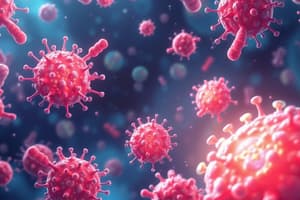Podcast
Questions and Answers
Which characteristic is most important for an ideal antimicrobial agent?
Which characteristic is most important for an ideal antimicrobial agent?
- It must only inhibit the growth of the microbial agent.
- It must cause some damage or adverse effect to the patient to indicate its efficacy.
- It must exhibit selective toxicity, being toxic to the microbial cell but not to the host's body. (correct)
- It must be toxic to the host's body to ensure complete eradication of the microbial agent.
Why are bactericidal agents preferred over bacteriostatic drugs in antibiotic choices?
Why are bactericidal agents preferred over bacteriostatic drugs in antibiotic choices?
- Bactericidal agents have a broader spectrum of activity.
- Bactericidal agents completely kill microorganisms, leading to quicker resolution of infection. (correct)
- Bactericidal agents are more effective against viral infections as well.
- Bactericidal agents are less likely to cause adverse effects.
How do aminoglycosides inhibit protein synthesis?
How do aminoglycosides inhibit protein synthesis?
- By causing the formation of non-functional complexes and misreading. (correct)
- By acting on peptidyl transferase enzyme.
- By interfering with the synthesis of ergosterol.
- By binding to a protein in the 50S of ribosomes.
Which of the following describes the mechanism by which polymyxins act on bacterial cells?
Which of the following describes the mechanism by which polymyxins act on bacterial cells?
Which mechanism of drug resistance involves bacteria producing proteins similar in structure to the antibiotic's target?
Which mechanism of drug resistance involves bacteria producing proteins similar in structure to the antibiotic's target?
What is the primary action of beta-lactam antibiotics?
What is the primary action of beta-lactam antibiotics?
Which of the following best describes 'intrinsic resistance' in bacteria?
Which of the following best describes 'intrinsic resistance' in bacteria?
Which of the following is NOT a factor that contributes to the development of antimicrobial resistance?
Which of the following is NOT a factor that contributes to the development of antimicrobial resistance?
What is the action of chloramphenicol on bacterial protein synthesis?
What is the action of chloramphenicol on bacterial protein synthesis?
Which of the following describes the function of efflux pumps in bacterial resistance to antibiotics?
Which of the following describes the function of efflux pumps in bacterial resistance to antibiotics?
What is the mechanism of action of trimethoprim and sulfonamides?
What is the mechanism of action of trimethoprim and sulfonamides?
What distinguishes a narrow-spectrum antibiotic from a broad-spectrum antibiotic?
What distinguishes a narrow-spectrum antibiotic from a broad-spectrum antibiotic?
A bacterium alters the structure of its ribosomes, preventing a certain antibiotic from binding. Which resistance mechanism is at play?
A bacterium alters the structure of its ribosomes, preventing a certain antibiotic from binding. Which resistance mechanism is at play?
Vancomycin inhibits bacterial cell wall synthesis by binding to:
Vancomycin inhibits bacterial cell wall synthesis by binding to:
How do antifungal azoles work?
How do antifungal azoles work?
Flashcards
Antibiotics
Antibiotics
Substances produced from microorganisms or synthetically that can inhibit or destroy microorganisms, even at low concentrations.
Ideal Antimicrobial Agent
Ideal Antimicrobial Agent
Kill the microbial agent or inhibit its growth without harming the patient.
Broad Spectrum Antibiotics
Broad Spectrum Antibiotics
Antibiotics with a wide coverage of activity against a wide spectrum of microorganisms.
Narrow Spectrum Antibiotics
Narrow Spectrum Antibiotics
Signup and view all the flashcards
Bactericidal
Bactericidal
Signup and view all the flashcards
Bacteriostatic
Bacteriostatic
Signup and view all the flashcards
Locally-Acting Antibiotic
Locally-Acting Antibiotic
Signup and view all the flashcards
Systematically-Acting Antibiotic
Systematically-Acting Antibiotic
Signup and view all the flashcards
β-Lactam antibiotics
β-Lactam antibiotics
Signup and view all the flashcards
Glycopeptides
Glycopeptides
Signup and view all the flashcards
Cationic Agents
Cationic Agents
Signup and view all the flashcards
Azoles
Azoles
Signup and view all the flashcards
Spectinomycin
Spectinomycin
Signup and view all the flashcards
Trimethoprim and Sulfonamides
Trimethoprim and Sulfonamides
Signup and view all the flashcards
Acquired Resistance
Acquired Resistance
Signup and view all the flashcards
Study Notes
- Antibiotics and antimicrobials are substances from microorganisms or made synthetically.
- These substances inhibit or destroy microorganisms, even in low concentrations.
- Natural sources of antibiotics include fungi and bacteria. Penicillin comes from the fungus Penicillium for example.
- Antibiotics treat infectious diseases.
- Ideal antimicrobials kill or inhibit microbial growth, have a broad activity spectrum, do not harm the patient, are stable in storage (solid or liquid), remain effective in body tissues, kill or inhibit organisms before mutation, and exhibit selective toxicity.
Spectrum of Activity
- Broad-spectrum antibiotics target a wide range of microorganisms.
- Narrow-spectrum antibiotics target a limited number of microorganisms.
Antimicrobial Activity
- Bactericidal antibiotics kill microorganisms.
- Bacteriostatic antibiotics only inhibit microorganism growth.
- Bactericidal agents are preferred over bacteriostatic drugs in the choice of antibiotics.
Absorbability from Site of Administration
- Locally-acting antibiotics limit their action to the administration site, for example, topical ointments or eye drops.
- Systematically-acting antibiotics affect several body systems when administered intramuscularly or intravenously.
Mechanism of Action
Agents that Interfere with Bacterial Cell Wall Synthesis
- Beta-lactam antibiotics (penicillins and cephalosporin) inhibit immature peptidoglycan's conversion to mature peptidoglycan by directly inhibiting bacterial transpeptidase, also called penicillin-binding proteins (PBPs).
- Glycopeptides (e.g., vancomycin) inhibit transglycosylase and transpeptidase enzymes involved in peptidoglycan synthesis.
Agents that Alter Cell Membrane Function/Permeability
- Includes cationic, anionic, neutral agents, and antifungal drugs.
- Polymyxin B and colistemethate (polymyxin E) are cationic agents that disrupt the outer membrane, allowing entry into the cell to inhibit metabolic processes.
- Antifungal drugs (nystatin, amphotericin B) alter cell membrane permeability.
- Azoles (clotrimazole, ketoconazole, miconazole, fluconazole) interfere with ergosterol synthesis in fungal cell membranes.
Agents that Inhibit Protein Synthesis
- Targets the 30S or 50S ribosomal subunits.
- Inhibitors of the 30S ribosomal subunit primarily interfere with the initiation process, for example, aminoglycosides and tetracycline.
- Aminoglycosides cause non-functional complexes and misreading.
- Spectinomycin binds to a protein in the 30S ribosome different from aminoglycosides.
- Agents binding to the 50S ribosomal subunit inhibit the elongation process, including chloramphenicol, macrolides, and lincinoids.
- Chloramphenicol inhibits peptide bond formation by binding to peptidyl transferase, effective against gram-positive and gram-negative organisms and is bacteriostatic.
- Macrolides interfere with peptidyl transferase, inhibiting its reaction and translocation, and erythromycin inhibits gram-positive and gram-negative bacteria.
- Lincinoids or lincosamines, like macrolides, bind to both 30S and 50S ribosomal subunits, including gentamycin and kanamycin.
Agents that Inhibit Microbial Metabolic Pathways
- Trimethoprim and sulfonamides interfere with folic acid metabolism, acting as competitive inhibitors that are important in the synthesis of DNA, RNA, and bacterial cell wall proteins.
Mechanisms of Drug Resistance
- Drug resistance is a growing concern.
- Organisms develop resistance when antibiotics no longer affect them, either through innate or acquired mechanisms.
- Intrinsic resistance is a stable genetic property encoded in the chromosome and shared by all strains of the species.
- Acquired resistance arises from the organism's ability to resist an antimicrobial drug to which it is normally susceptible, developed over time due to constant exposure to the agent but not normally encoded on the chromosome.
Factors that Contribute to Antimicrobial Resistance
- Overuse of broad-spectrum antibiotics by over-prescription.
- Incorrect diagnosis leading to inappropriate antibiotic use.
- Unnecessary prescription of antibiotics when they’re not needed.
- Indiscriminate/improper antibiotic use by patients.
- Using antibiotics as additives in livestock feeds to improve growth.
Mechanisms of Drug Resistance
- Drug modification or inactivation occurs when resistance genes code for enzymes that alter or inactivate the antibiotic, or cause its hydrolysis.
- Prevention of cellular uptake or efflux prevents the antibiotic from accumulating in the bacterial cell; efflux pumps effectively remove antimicrobials.
- Modification of target sites involves changing the structure of antimicrobial targets, preventing the antibiotic from binding effectively.
Examples of Antimicrobial Target Sites
- Modified peptides sub-units of peptidoglycan involve glycopeptides.
- Modified Ribosome sub-units involve Macrolides, tetracyclines, aminoglycosides.
- Modified Metabolic enzymes involve Sulfa drugs, sulfones, trimethoprim.
- Modified Lipopolysaccharide structure involve polymyxins.
- Modified DNA gyrase involve fluoroquinolones.
- Modified RNA polymerase involve rifampin. Overproduction or bypass of target enzymes: bacteria overcome antibiotics by overproducing the target enzyme, ensuring enough free enzyme for essential reactions. Target mimicry: bacteria produce proteins similar in structure to the antibiotic target sites, causing the antimicrobial to bind the new proteins instead of the target protein.
Studying That Suits You
Use AI to generate personalized quizzes and flashcards to suit your learning preferences.





